
Concept explainers
(a)
Interpretation:
For the given species, the complete Lewis structure is to be completed by adding multiple bonds and/or lone pairs.
Concept introduction:
In order to draw a Lewis structure for a molecule, start by counting the total number of valence electrons in a molecule. The number of valence electrons by each atom is the same as its group number. For the given skeleton of the molecule, distribute the remaining electrons as lone pairs. In doing so, start with the outer atoms and work inwards. Try to achieve an octet on each atom other than hydrogen. If there is an atom with less than an octet, increase the atom’s share of electrons by converting lone pairs from neighboring atoms to bonding pairs thereby creating double or triple bonds. For an uncharged atom, carbon atoms will have a maximum of four bonds; Nitrogen will have three bonds and one lone pair, while oxygen will have two bonds and two lone pairs. Hydrogen always contributes to one bond. The number of bonds in case of halogen is one; while there will be three lone pair of electrons on halide atoms.
Answer to Problem 1.24P
The complete Lewis structure for the given species is:
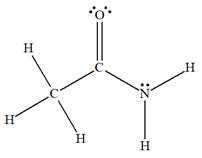
Explanation of Solution
The given species is:
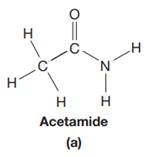
The formula for the species above is
The carbon atom on the left side has four bonds, thus, its octet is complete. The carbon atom in the middle has four bonds, hence, its octet is also complete. The nitrogen atom has three bonds, thus, its octet is not complete. There should be one lone pair of electron on nitrogen. The double bonded oxygen atom has got two bonds. Thus, in order to complete its octet, it should possess two lone pair of electrons. Thus, all the
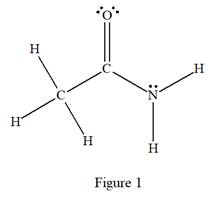
The complete Lewis structure for the given species including multiple bonds and lone pairs is shown in Figure 1 above.
(b)
Interpretation:
For given species, the complete Lewis structure is to be completed by adding multiple bonds and/or lone pairs.
Concept introduction:
In order to draw a Lewis structure for a molecule, start by counting the total number of valence electrons in a molecule. The number of valence electrons by each atom is the same as its group number. For a charged species, each negative charge increases the number of valence electrons by one while each positive charge decreases the number of valence electrons by one. For the given skeleton of the molecule, distribute the remaining electrons as lone pairs. In doing so, start with the outer atoms and work inwards. Try to achieve an octet on each atom other than hydrogen. If there is an atom with less than an octet, increase the atom’s share of electrons by converting lone pairs from neighboring atoms to bonding pairs thereby creating double or triple bonds. For an uncharged atom, carbon atoms will have maximum of four bonds. Nitrogen will have three bonds and one lone pair, while oxygen will have two bonds and two lone pairs. Hydrogen always contributes to one bond. The number of bond in case of halogen is one, while there will be three lone pair of electrons on halide atoms.
Answer to Problem 1.24P
The complete Lewis structure for the given species is:

Explanation of Solution
The given species is:
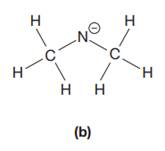
The formula for the species above is
The carbon atom on the left as well as on the right has four bonds, thus, their octets are complete. The nitrogen atom has two bonds and a negative formal charge. This suggests that the remaining four electrons should be present on the nitrogen atom so as to complete its octet and have a negative formal charge. Thus, the complete Lewis structure for the given species is:

The complete Lewis structure for the given species including multiple bonds and lone pairs is shown in Figure 2 above.
(c)
Interpretation:
For given species, the complete Lewis structure is to be completed by adding multiple bonds and/or lone pairs.
Concept introduction:
In order to draw a Lewis structure for a molecule, start by counting the total number of valence electrons in a molecule. The number of valence electrons by each atom is the same as its group number. For a charged species, each negative charge increase the number of valence electrons by one while each positive charge decrease the number of valence electrons by one. For the given skeleton of the molecule, distribute the remaining electrons as lone pairs. In doing so, start with the outer atoms and work inwards. Try to achieve an octet on each atom other than hydrogen. If there is an atom with less than an octet, increase the atom’s share of electrons by converting lone pairs from neighboring atoms to bonding pairs thereby creating double or triple bonds. For an uncharged atom, carbon atoms will have maximum of four bonds. Nitrogen will have three bonds and one lone pair, while oxygen will have two bonds and two lone pairs. Hydrogen always contributes to one bond. The number of bond in case of halogen is one, while there will be three lone pair of electrons on halide atoms.
Answer to Problem 1.24P
The complete Lewis structure for the given species is:
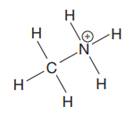
Explanation of Solution
The given species is:
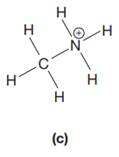
The formula for the species above is
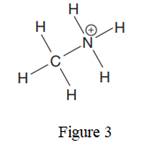
The complete Lewis structure for the given species including multiple bonds and lone pairs is shown in Figure 2 above.
(d)
Interpretation:
For given species, the complete Lewis structure is to be completed by adding multiple bonds and/or lone pairs.
Concept introduction:
In order to draw a Lewis structure for a molecule, start by counting the total number of valence electrons in a molecule. The number of valence electrons by each atom is the same as its group number. For a charged species, each negative charge increase the number of valence electrons by one while each positive charge decrease the number of valence electrons by one. For the given skeleton of the molecule, distribute the remaining electrons as lone pairs. In doing so, start with the outer atoms and work inwards. Try to achieve an octet on each atom other than hydrogen. If there is an atom with less than an octet, increase the atom’s share of electrons by converting lone pairs from neighboring atoms into bonding pairs thereby creating double or triple bonds. For an uncharged atom, carbon atoms will have maximum of four bonds. Nitrogen will have three bonds and one lone pair, while oxygen will have two bonds and two lone pairs. Hydrogen always contributes to one bond. The number of bond in case of halogen is one, while there will be three lone pair of electrons on halide atoms.
Answer to Problem 1.24P
The complete Lewis structure for the given species is:
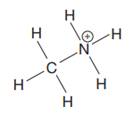
Explanation of Solution
The given species is:

The formula for the species above is
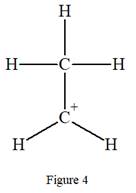
The complete Lewis structure for the given species including multiple bonds and lone pairs is shown in Figure 4 above.
Want to see more full solutions like this?
Chapter 1 Solutions
Get Ready for Organic Chemistry
- Draw a tetramer of this alternating copolymer.arrow_forwardH I T H HH H -H C. H- Identify and select all structures below that represent a constitutional isomer(s) of the compound shown above. H- H CIH H H H HHHH H H 0 ·H H– 冊 CH CHI HH C- H- H H- H H A. H H C H H- -H HH H B. H- -H D. H H H H • H -H E. -H H H HICH T HHH F. H-arrow_forwardPolylactic acid (shown below) is a biodegradable polymer used for food packaging. Identify the monomer(s) used in the production of this polymer using a condensation process.arrow_forward
- Draw the product of the reaction shown below. Ignore small byproducts that would evaporate pleasearrow_forwardPoly(ethylene adipate) is a biodegradable polyester (shown below). Identify the type of polymerization process used in the production of this polymer.arrow_forwardPolymers may be composed of thousands of monomers. draw two repeat units(dimer) of the polymer formed in this reaction. assume there are hydrogen atoms on the two ends of the dimer. ignore inorganic byproducts pleasearrow_forward
- Draw the product of the reaction shown below. Use a dash or wedge bond to indicate stereochemistry of substituents on asymmetric centers, Ignore inorganic byproductsarrow_forwardDraw the product of this reaction please. Ignore inorganic byproductsarrow_forwardOne of the pi molecular orbitals of 1,3-butadiene (CH2=CHCH=CH2) is shown below. Please identify the number of nodal planes perpendicular to the bonding axisarrow_forward
- Draw the monomers required to synthesize this condensation polymer please.arrow_forwardProvide the correct systematic name for the compound shown here. Please take into account the keyboard options belowarrow_forwardcurved arrows are used to illustrate the flow of electrons. using the provided starting and product structures, draw the curved electron-pushing arrows for the following reaction or mechanistic step(s)arrow_forward
 Organic Chemistry: A Guided InquiryChemistryISBN:9780618974122Author:Andrei StraumanisPublisher:Cengage Learning
Organic Chemistry: A Guided InquiryChemistryISBN:9780618974122Author:Andrei StraumanisPublisher:Cengage Learning Introductory Chemistry: An Active Learning Approa...ChemistryISBN:9781305079250Author:Mark S. Cracolice, Ed PetersPublisher:Cengage Learning
Introductory Chemistry: An Active Learning Approa...ChemistryISBN:9781305079250Author:Mark S. Cracolice, Ed PetersPublisher:Cengage Learning

